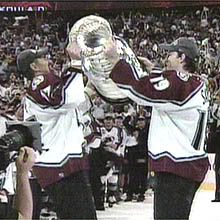Post by annabelleleigh on Aug 11, 2009 9:33:31 GMT -5
I just stumbled over this piece and found the prospect repugnant. It's an argument for eschewing TV altogether and renting or buying (ad-free) CDs of favorite shows.
Personally I have zero tolerance for "messier media venues" -- and I don't put much stock in research using "aided recall." (See piece below).
If you watch television in the U.S., this proposal could affect you. What do you think?
AL
P.S. Boldface mine.
---------------------------------
Plethora of Promos Will Soon Mob Your TV Screen
Tolerance of 'Messy' Media Prompts Testing of Top-to-Bottom Ads
By Brian Steinberg
Ad Age
August 10, 2009
Excerpt:
"The TV screen may be about to get it from all sides: TV networks and advertisers are quietly testing whether consumers will respond to promos and ads that run on the top and bottom sectors of the boob tube -- while some of their favorite programs are airing.
Walt Disney recently disclosed that its ABC and ESPN TV networks are testing the efficiency of "upper-third messaging," or graphics that appear in the top third of the TV screen. This comes after IAC Corp.'s Ask.com search site ran "crawl" ads along the bottom of the TV screen on selected networks earlier this year, marking one of the first times full-fledged advertising has run during a program, not just in the ad breaks that disrupt it.
In the past decade, consumers have developed a "capacity to accept multiple messaging all at once," said Adam Stotsky, president-marketing, NBC Entertainment. As a result, these types of promos have become "a given of the current TV landscape -- cable and network," said George Schweitzer, president, CBS Marketing Group.
The desire to turn the TV screen into more fertile promotional territory has taken on greater importance. With nearly 30% of U.S. homes with TVs slated to have DVRs by the end of 2009, according to Interpublic Group's Magna, couch potatoes are better armed to breeze past traditional TV ads. Consumers also have a higher tolerance for messier media venues, whether they take the form of a cluttered, multi-screen computer desktop or sports programming and cable news shows with an abundance of onscreen information. All that provides justification for TV networks looking to run more-intrusive promotional entreaties.
Advertisers have already found that in-show ads, as they are sometimes called, are memorable to viewers. When Ask.com ran crawls at the bottom of the screen during Nascar races, the company found that the ads drove a "significantly" higher volume of queries to its search site than a traditional 15-second ad, said John Moore, director-ideas and innovations at Interpublic Group's Mullen, the agency that negotiated placement of the ads. Use of the crawls continues to be a "key" strategy, Mr. Moore said.
Middle ground
Likewise, ABC has discovered that a mix of content and advertising can drive recall as well as a viewer's purchase intent. When ABC's "Good Morning America" laced an ad into a graphic that contained national weather information -- the ad ran in the middle of the screen, while weather info appeared along the borders -- the results were hard to ignore. ABC found that aided recall of the advertiser was 24% higher when the ad was shown in the weather graphic vs. when it was shown in a traditional commercial break. Unaided recall was an average of 29% higher.
TV executives say they want to show appropriate care, even as they continue to test new ideas that will appeal to new viewer willingness to encounter ads mixed in with programs. "While I think viewers can handle a lot, that doesn't mean they necessarily want to," said Peter Seymour, executive VP-strategy and research for Disney Media Networks. Programmers will have to "find that balance," he added.
Already some programmers have tried things onscreen that have raised eyebrows. Last summer, TBS ran a promo for its "Bill Engvall Show" that had Mr. Engvall click a remote to stop the action of a show running over his head so attention had to be paid to his pitch. NBC took things a step further: The Peacock has run ads for movies such as "American Gangster" and "Evan Almighty" -- produced by an NBC Universal sibling studio -- during first-run episodes of "Heroes."
The story continues at
adage.com/mediaworks/article?article_id=138366
Personally I have zero tolerance for "messier media venues" -- and I don't put much stock in research using "aided recall." (See piece below).
If you watch television in the U.S., this proposal could affect you. What do you think?
AL
P.S. Boldface mine.
---------------------------------
Plethora of Promos Will Soon Mob Your TV Screen
Tolerance of 'Messy' Media Prompts Testing of Top-to-Bottom Ads
By Brian Steinberg
Ad Age
August 10, 2009
Excerpt:
"The TV screen may be about to get it from all sides: TV networks and advertisers are quietly testing whether consumers will respond to promos and ads that run on the top and bottom sectors of the boob tube -- while some of their favorite programs are airing.
Walt Disney recently disclosed that its ABC and ESPN TV networks are testing the efficiency of "upper-third messaging," or graphics that appear in the top third of the TV screen. This comes after IAC Corp.'s Ask.com search site ran "crawl" ads along the bottom of the TV screen on selected networks earlier this year, marking one of the first times full-fledged advertising has run during a program, not just in the ad breaks that disrupt it.
In the past decade, consumers have developed a "capacity to accept multiple messaging all at once," said Adam Stotsky, president-marketing, NBC Entertainment. As a result, these types of promos have become "a given of the current TV landscape -- cable and network," said George Schweitzer, president, CBS Marketing Group.
The desire to turn the TV screen into more fertile promotional territory has taken on greater importance. With nearly 30% of U.S. homes with TVs slated to have DVRs by the end of 2009, according to Interpublic Group's Magna, couch potatoes are better armed to breeze past traditional TV ads. Consumers also have a higher tolerance for messier media venues, whether they take the form of a cluttered, multi-screen computer desktop or sports programming and cable news shows with an abundance of onscreen information. All that provides justification for TV networks looking to run more-intrusive promotional entreaties.
Advertisers have already found that in-show ads, as they are sometimes called, are memorable to viewers. When Ask.com ran crawls at the bottom of the screen during Nascar races, the company found that the ads drove a "significantly" higher volume of queries to its search site than a traditional 15-second ad, said John Moore, director-ideas and innovations at Interpublic Group's Mullen, the agency that negotiated placement of the ads. Use of the crawls continues to be a "key" strategy, Mr. Moore said.
Middle ground
Likewise, ABC has discovered that a mix of content and advertising can drive recall as well as a viewer's purchase intent. When ABC's "Good Morning America" laced an ad into a graphic that contained national weather information -- the ad ran in the middle of the screen, while weather info appeared along the borders -- the results were hard to ignore. ABC found that aided recall of the advertiser was 24% higher when the ad was shown in the weather graphic vs. when it was shown in a traditional commercial break. Unaided recall was an average of 29% higher.
TV executives say they want to show appropriate care, even as they continue to test new ideas that will appeal to new viewer willingness to encounter ads mixed in with programs. "While I think viewers can handle a lot, that doesn't mean they necessarily want to," said Peter Seymour, executive VP-strategy and research for Disney Media Networks. Programmers will have to "find that balance," he added.
Already some programmers have tried things onscreen that have raised eyebrows. Last summer, TBS ran a promo for its "Bill Engvall Show" that had Mr. Engvall click a remote to stop the action of a show running over his head so attention had to be paid to his pitch. NBC took things a step further: The Peacock has run ads for movies such as "American Gangster" and "Evan Almighty" -- produced by an NBC Universal sibling studio -- during first-run episodes of "Heroes."
The story continues at
adage.com/mediaworks/article?article_id=138366







 Patrick Roy, 2006 inductee into the Hockey Hall of Fame
Patrick Roy, 2006 inductee into the Hockey Hall of Fame
